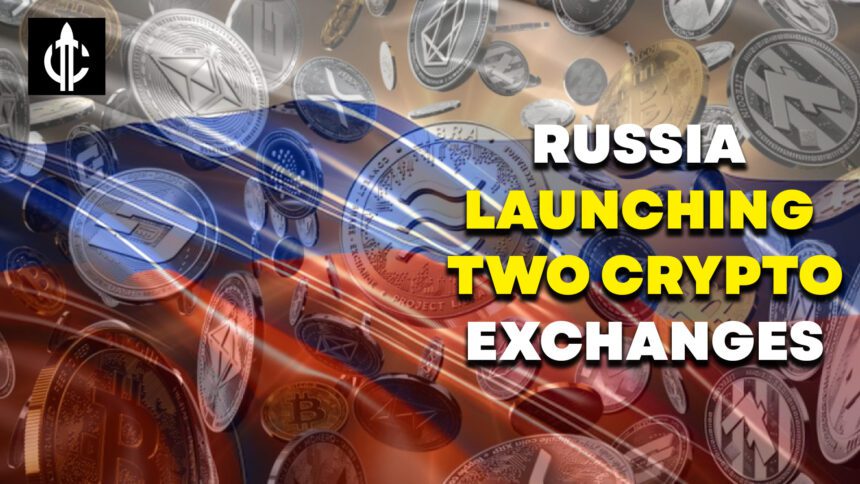Now, Russia intends to open two major cryptocurrency exchanges, one in St. Petersburg and one in Moscow. Petersburg. This drive highlights the need to help unfamiliar financial action (FEA). In addition, the nation intends to construct a BRICS stablecoin pegged to the Chinese yuan, thereby intensifying efforts to dedollarize.
The crypto trade drive is intended to give another stage to computerized exchanges. However, experts have voiced concerns regarding the project’s potential restrictions and dangers, particularly in light of international sanctions.
Russia’s Plans for Expanding the Cryptocurrency Industry
One of the crypto trades will probably use the foundation of the St. According to a Kommersant report, Petersburg Currency Exchange (SPCE) was established to facilitate foreign economic activity. The other platform, on the other hand, is likely to be based in Moscow. However, it is still unknown whether it will be developed independently within an experimental legal framework or on the basis of the existing Moscow Exchange.


Stablecoin creation and usage will be the primary focus of these exchanges. For setting, stablecoins are a sort of crypto that is regularly fixed to a hold of resources, like a public money or a crate of monetary standards. In this instance, stablecoins linked to the BRICS currency basket and the Chinese Renminbi (RMB) Yuan are reportedly being considered by the Russian government.
As a result, the BRICS countries’ (Brazil, Russia, India, China, and South Africa) economic cooperation is being bolstered by this move. Currently, BRICS is considering cryptocurrency and blockchain dedollarization. However, there are a number of obstacles that must be overcome before a BRICS stablecoin can be developed and used on recently launched cryptocurrency exchanges.
Top 3 Ethereum Coins with Potential of 100x Returns
Read more
Oleg Ogienko, President of BitRiver, called attention to the mechanical hardships in coordinating stablecoins into Russia’s blockchain framework. “Stablecoins, due to their legal nature, are more like cryptocurrency,” he said. Their convertibility, liquidity, and security may be compromised as a result. Additionally, Russia’s seamless adoption of stablecoins could be hindered by the complexity of these issues.
Challenges and the Present Regulatory Framework for Cryptocurrency Exchanges
As far as administrative systems, Russia at present works under Government Regulation No. “On Digital Financial Assets” in 259 The legal foundation for the distribution and issuance of digital assets is provided by this regulation. However, neither the establishment of cryptocurrency exchanges nor their regulation are specifically addressed in this legislation.
According to Yaroslav Schitzle of the law firm Rustam Kurmaev and Partners, the current regulation in Russia does not provide for a “clear and unified legal mechanism for the creation and operation of crypto exchanges.” The Experimental Legal Regime (EPR) is the sole relevant regulation that is available. This regulation was as of late sanctioned and could act as the lawful starting point for these new cryptographic money trades.
Join our Telegram Channel for Free Cryto Signals and Charts: t.me/coinextoday


It is anticipated that these cryptocurrency exchanges will be launched in stages. In the beginning, only a select few users will be able to access the system. These incorporate auxiliaries of significant exporters and merchants, frequently alluded to as “blue chips” in the business world.
The opinion of Mikhail Uspensky, who is a member of the State Duma expert council on the legislative regulation of cryptocurrencies, was expressed. He noted it is impossible that little and medium-sized organizations or individual clients will be conceded unhindered access in the beginning stages. In addition, he emphasized that “the regulator is entirely in charge of the contours of the future experiment.”
Also Read: Kraken Expands Shiba Inu Support with New Margin Trading Pair
Ramifications Of Worldwide Approvals
The project is fraught with significant risks, particularly in regards to sanctions, despite the potential benefits. If transaction data were to leak, the transparency of blockchain technology could have serious repercussions.
That’s what uspensky cautioned assuming it becomes realized that a cryptographic money was bought on a Russian trade, this data could be followed and hailed as dubious. Transactions could be stopped as a result of this. He warned that the participants in these transactions’ lives could be “significantly ruined” in such a situation.
Moreover, it could likewise influence future holders of these advanced resources who might have no immediate association with Russia. Additionally, experts such as TerraCrypto founder Nikita Vassev questioned the appeal of these domestic platforms.
That’s what he contended “just the individuals who have no other decision will utilize such a trade.” Vassev suggested that most users will continue to choose established, well-known trading platforms unless there are no other options available.
Recently, the nation took on a favorable to crypto approach by legitimizing crypto and Bitcoin mining. India, Russia’s BRICS neighbor, is anticipating the start of crypto regulatory efforts. The Indian government is looking for popular assessment for better system. The release from the DEA, expected in September or October, will serve as the foundation for the nation’s regulation of digital assets.
Also Read: 3 XRP Alternatives Coins for 100x Gains








